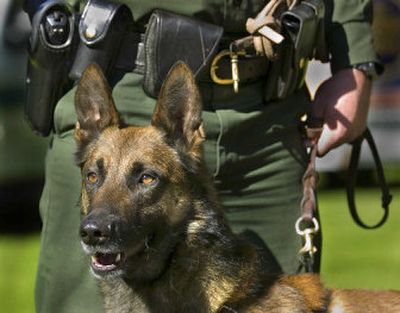Dogs beefing up border security

Drug runners, illegal aliens and even potential terrorists will now have to contend with tough new employees of the U.S. Department of Homeland Security’s border protection force.
Say hello to Gordon, Ronnie and Beau. But please don’t give them any table scraps, their agent-handlers say.
The three shepherds are part of a dramatic buildup of K9 teams along the nation’s most remote stretches of border, from Eastern Washington to Western Montana.
Last year at this time, just one team was posted along the sector. By the end of June, a total of 14 of the specially trained dog teams will be posted across the region, making it the nation’s only stretch of border where all the K9 teams have the most advanced level of training possible, said Robert Harris, the U.S. Border Patrol’s chief agent for the sector.
“I realize what an asset they are,” Harris said, explaining his push to add K9 teams. “What I want to do is give my agents all the best tools, whether it’s a snowmobile, a K9, an all-terrain vehicle or a horse.”
All the dogs have 16 weeks of training, plus experience along the border with Mexico. Gordon, a Belgian Malinois, has 190 successful manhunts under his collar, said his handler, agent Chad Hickman. Gordon’s longest track was 11 miles through dry desert. The northern border doesn’t offer as much frequency in terms of tracking aliens, but the conditions can be more rugged and remote, Hickman said. The wet forests of the Inland Northwest provide ideal scent conditions for the dogs.
“The more vegetation the better for tracking,” Hickman said.
Several of the K9 teams offered a demonstration Friday morning outside the Border Patrol’s sector headquarters on Spokane’s North Side. Gordon sat at his handler’s feet, his nose slightly cocked to the breeze, as Hickman talked about his dog’s abilities in front of a small audience from the U.S. attorney’s office. The officials were invited to witness Gordon’s powerful nose – soon, they will likely begin prosecuting fugitives nabbed by this nose.
Before Gordon arrived, one agent ran across the lawn and through the forest near the headquarters building. The agent crossed a road, then a parking lot, eventually hiding behind a shed several hundred yards from Gordon. Hickman attached a 10-foot leather lead to the dog, then followed behind as Gordon’s nose retraced each step of the fake fugitive. Within a minute, Gordon had found the man, prompting polite applause from the prosecutor’s office.
When Gordon catches a suspect, he doesn’t attack. He’s trained to sit until his handler offers a reward, which is nothing more than a cylindrical toy. Gordon works only because he wants to play, Hickman explained.
Although Gordon and his counterparts have noses sensitive enough to sniff out a single gram of marijuana hidden away in a vehicle’s gas cap – from several yards away – their real skill is in tracking humans, Hickman said.
The dogs have noses sharp enough to follow fugitives across pavement. Experts aren’t entirely sure how the dogs do it, Hickman said. It might be from the tiny amounts of skin cells that fall from the body with each step. It could be from the micropuffs of scent released from the ground with each footfall. Whatever it is, agents say no technology compares with the olfactory nerves of these dogs.
“They haven’t really been able to factor our how or why,” said Hickman, a certified K9 instructor stationed at Metaline Falls, Wash. “Maybe they smell the fear or the adrenaline.”
One agent at the demonstration said his dog has found humans hidden inside dashboards and one person squeezed inside a suitcase.
The dogs will spend most of their time patrolling the mountainous backcountry between the highway border crossings, but they will occasionally be called in for “pulse” checks at the border stations, Harris said. The agency has also offered to help local law enforcement find lost hunters or other missing persons.
Agents say they try to keep a slight emotional distance with the dogs, but it’s not easy. The agents work alone; their only partners are the dogs. They also live with the dogs.
Agent Virgil Armstrong, who is stationed at Bonners Ferry, Idaho, with a 17-month-old German shepherd, said the dogs are eager to go to work each day. It’s hard not to be in awe of their dedication and abilities, he said.
“It’s something we say in the K9 community: Trust your dog, your dog will not lead you wrong,” Armstrong said.